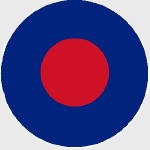Hobby Master HA6607 RAF Eurofighter EF2000 Typhoon Multi-Role Fighter - ZK349, No.29(R) Squadron, "75th Anniversary of the Battle of Britain", 2015 [Anniversary Scheme] (1:72 Scale)
"What General Weygand called the 'Battle of France' is over. I expect that the Battle of Britain is about to begin."
- Prime Minister Winston Churchill speaking before the House of Commons, June 18th, 1940
 The four-nation Eurofighter Typhoon is a foreplane delta-wing, beyond-visual-range, close air fighter aircraft with surface attack capability. Eurofighter has 'supercruise' capability: it can fly at sustained speeds of over Mach 1 without the use of afterburner.
The four-nation Eurofighter Typhoon is a foreplane delta-wing, beyond-visual-range, close air fighter aircraft with surface attack capability. Eurofighter has 'supercruise' capability: it can fly at sustained speeds of over Mach 1 without the use of afterburner.
Development of the aircraft has been carried out by Eurofighter GmbH, based in Munich and wholly owned by BAE Systems of the UK, Alenia Aeronautica of Italy and the EADS Deutschland (formerly DaimlerChrysler) and EADS Spain (formerly CASA). In January 2003, Norway signed an agreement for industrial participation in the project, but has not committed to purchase of the fighter. The EJ200 engine has been developed by Eurojet GmbH, in Munich which is owned by Rolls Royce, MTU Aero Engines, Fiat Aviazione and ITP.
One major advantage of the aircraft over current types is its ability to undertake 'swing role' missions. For these, Typhoon can be equipped to undertake both air-to-air and air-to-ground missions in a single sortie, switching between the two separate attack modes in flight, something not possible with a Tornado GR4 for example. And with nine underwing weapon-mounting points, Typhoon will be equipped with 2 x Advanced Short-Range Air-to-Air Missiles (ASRAAMs), 4 x Advanced Medium-Range Air-to-Air Missiles (AMRAAMs) whilst simultaneously carrying air-to-surface ordnance which could include Laser Guided Bombs (Paveway 2 and 3 or Enhanced Paveway), Brimstone anti-armour weapon, Storm Shadow cruise missiles and Air Launched Anti-Radiation Missiles (ALARMs), the aircraft packs a mighty punch. Ultimately, Meteor, a combination of rocket and air-breathing technology, will replace AMRAAM as Typhoon's primary long range air-to-air missile.
Pictured here is a 1:72 scale replica of a RAF Eurofighter EF2000 Typhoon multi-role fighter that was attached to No.29(R) Squadron and clad in a "75th Anniversary of the Battle of Britain" scheme. This model comes with a full weapons loadout.
Now in stock!
Dimensions:
Wingspan: 6-inches
Length: 8-3/4-inches
Release Date: January 2021
Historical Account: "The Battle of Britain" - The Battle of Britain (German: die Luftschlacht um England, "the Air Battle for England") was a military campaign of the Second World War, in which the Royal Air Force (RAF) defended the United Kingdom (UK) against large-scale attacks by Nazi Germany's air force, the Luftwaffe. It has been described as the first major military campaign fought entirely by air forces. The British officially recognize the battle's duration as being from July 10th until October 31st, 1940, which overlaps the period of large-scale night attacks known as the Blitz, that lasted from September 7th, 1940, to May 11th, 1941. German historians do not accept this subdivision and regard the battle as a single campaign lasting from July 1940 to June 1941, including the Blitz.
The primary objective of the German forces was to compel Britain to agree to a negotiated peace settlement. In July 1940, the air and sea blockade began, with the Luftwaffe mainly targeting coastal-shipping convoys, ports and shipping centers, such as Portsmouth. On August 1st, the Luftwaffe was directed to achieve air superiority over the RAF, with the aim of incapacitating RAF Fighter Command; 12 days later, it shifted the attacks to RAF airfields and infrastructure. As the battle progressed, the Luftwaffe also targeted factories involved in aircraft production and strategic infrastructure. Eventually, it employed terror bombing on areas of political significance and on civilians.
The Germans had rapidly overwhelmed France and the Low Countries, leaving Britain to face the threat of invasion by sea. The German high command recognized the logistic difficulties of a seaborne attack and its impracticality while the Royal Navy controlled the English Channel and the North Sea. On July 16th, Hitler ordered the preparation of Operation Sea Lion as a potential amphibious and airborne assault on Britain, to follow once the Luftwaffe had air superiority over the UK. In September, RAF Bomber Command night raids disrupted the German preparation of converted barges, and the Luftwaffe's failure to overwhelm the RAF forced Hitler to postpone, and eventually cancel Operation Sea Lion. Germany proved unable to sustain daylight raids, but their continued night-bombing operations on Britain became known as the Blitz.
Historian Stephen Bungay cited Germany's failure to destroy Britain's air defenses to force an armistice (or even an outright surrender) as the first major German defeat in World War II and a crucial turning point in the conflict. The Battle of Britain takes its name from the speech given by Prime Minister Winston Churchill to the House of Commons on June 18th: "What General Weygand called the 'Battle of France' is over. I expect that the Battle of Britain is about to begin."


